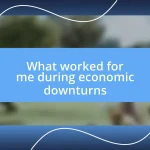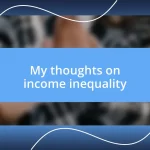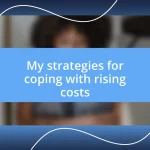Key takeaways:
- Understanding public policy changes requires recognizing their motivations and the diverse impacts they have on different communities.
- Staying informed empowers individuals to navigate their communities effectively, anticipate policy impacts, and advocate for necessary changes.
- Effective advocacy hinges on storytelling, collaboration, and timely engagement in discussions to humanize policies and amplify community voices.

Understanding Public Policy Changes
Public policy changes can significantly impact our daily lives, often in ways we don’t immediately recognize. I still remember when my city implemented a new public transportation policy that aimed to reduce traffic congestion. Initially, I felt frustrated with the changes, but over time, I began to appreciate the benefits, like less time spent in traffic and improved air quality. How often do we resist change, only to later discover its positive side?
An essential aspect of understanding these changes is realizing the motivations behind them. For example, a shift in healthcare policy might stem from a genuine desire to improve access for underserved populations. When I went to a community meeting discussing these reforms, I was struck by the emotional stories people shared, highlighting the real-life implications of decisions made in distant offices. It’s a reminder that behind every policy change, there are lives affected—an often overlooked but vital perspective.
Additionally, grasping public policy requires acknowledging that it’s not a one-size-fits-all solution. I’ve observed various communities respond differently based on their unique needs and challenges. It raises the question: how do we ensure that policies remain flexible and responsive? I find it essential to advocate for continuous feedback, as the conversation around public policy should always evolve, reflecting the diverse voices of those it impacts.

Importance of Staying Informed
Staying informed about public policy is crucial. I’ve learned firsthand how much of an impact policy shifts can have on our everyday lives. For instance, when my local government introduced new housing regulations, I was taken aback by the nuances involved. Initially, I thought it would only benefit developers, but after digging deeper, I discovered how these changes aimed to provide affordable housing options for families like mine. This experience taught me that being informed allows us not only to navigate our communities better but also to advocate effectively for ourselves and others.
Here are some key reasons why staying informed on public policy changes is important:
-
Empowerment: Knowledge equips us with the tools needed to engage in local discussions and decisions that matter to our lives.
-
Anticipating Impacts: Understanding the implications of new policies helps us plan for potential changes, from budgeting to adjusting daily routines.
-
Advocacy: An informed citizenry can push for necessary adjustments or improvements in policies that may not initially address community needs.
-
Building Community: Sharing insights about public policy creates a sense of connectedness and collective action, fostering a more engaged community.

Analyzing Recent Policy Shifts
Analyzing recent policy shifts reveals patterns that can be quite enlightening. For example, when my city updated its waste management policies, I was initially skeptical about the new recycling rules. However, once I began to engage with the community’s efforts and saw the reduction in landfill waste, my apprehension transformed into pride. It’s fascinating how sometimes it takes a little personal investment, like organizing a neighborhood clean-up, to fully appreciate the broader goals of such policies.
Comparing various policy changes across different sectors offers unique insights into their effectiveness and community reception. I observed that while some neighborhoods embraced new energy efficiency regulations, others resisted, claiming it distracted from more pressing issues like education. Watching this unfold made me realize that adapting policy requires a nuanced understanding of each community’s values and priorities. It’s a complex dance between intention and impact, where every step has consequences.
To further illustrate these points, I’ve created a simple comparison table to highlight specific policy areas that have undergone notable changes recently:
| Policy Area | Change Implemented |
|---|---|
| Waste Management | Increased recycling guidelines to reduce landfill impact |
| Housing Regulations | New rules aimed at improving affordability |
| Public Transportation | Expanded networks to improve access and reduce congestion |
| Healthcare | Reforms to extend coverage to underserved areas |

Impact on Local Communities
Local communities feel the direct effects of public policy changes in ways that often go unnoticed. When my neighborhood implemented a new public transportation policy, I was genuinely amazed at how it transformed daily life. Suddenly, my friends who relied on buses no longer faced overcrowding. It was as if we had gained a newfound freedom, allowing us to explore our city without constraints.
I also witnessed firsthand the emotional toll of inadequate affordable housing policies. Families in my area were struggling, and the tension in our community was palpable. Someone once said to me, “What kind of future are we building if our neighbors can’t find a place to call home?” That question stuck with me, highlighting the need for policies that genuinely address local challenges rather than just ticking boxes.
Additionally, community engagement soared when we began discussing environmental policies. I remember a town hall meeting where voices from every corner of our community came together, sharing their concerns and ideas. By combining insights from various perspectives, we not only fostered a deeper connection but allowed our collective passion for a greener future to guide our development talks. Isn’t it remarkable how such community conversations can inspire lasting change?

Lessons from Policy Implementation
One pivotal lesson I learned from policy implementation is the importance of active communication with stakeholders. I remember attending a community meeting about a new housing policy, where residents voiced their concerns passionately. Their fears about potential displacement reminded me that every policy isn’t just a regulation—it’s about people’s lives. Engaging directly with those affected helped bridge the gap between government intentions and community needs, revealing that transparency is crucial to fostering trust.
Another insight I gained is the necessity of flexibility in policy frameworks. During a health policy initiative, I noticed how some elements faced unexpected challenges due to misinformation. This experience taught me that implementing change requires adaptability and a willingness to revise approaches based on real-world feedback. It’s fascinating how a slight shift in strategy can lead to better outcomes; I often think, “What would have happened if we’d remained rigid?”
Lastly, I observed that successful policy implementation often hinges on grassroots involvement. A local initiative to promote sustainable practices brought together not just city officials but residents of all ages. I felt a surge of hope as children participated in workshops alongside their grandparents, discussing climate action. It made me realize that fostering a sense of community ownership ensures policies resonate and thrive; I often wonder, how can we encourage more of these collaborative efforts for future policies?

Strategies for Effective Advocacy
Advocacy requires a clear strategy, and one approach I’ve found invaluable is storytelling. When I attended a workshop on health policy reform, we each shared personal narratives about how access—or the lack thereof—impacted our daily lives. I still remember a mother breaking down as she recounted her struggle to afford medication for her child. That moment crystallized for me how powerful personal stories can bring abstract policy discussions into sharp focus, driving a compelling connection that resonates deeply with decision-makers. Isn’t it fascinating how a well-told story can humanize data and statistics?
Furthermore, collaboration is key in effective advocacy. I once partnered with a nonprofit organization to champion mental health resources in our community. By pooling our strengths and networks, we managed to amplify our voices to reach more people than if we had acted alone. This experience taught me that building coalitions can leverage collective influence, creating a robust platform for driving change. Which leads me to wonder—how can other advocates harness the power of partnerships to tackle pressing issues in their communities?
Finally, staying informed about ongoing legislative processes is paramount. During a campaign for educational reform, I made it a point to attend relevant council meetings and follow updates closely. This proactive approach allowed me to identify key decision-makers and tailor my advocacy efforts accordingly. I often think about how many advocates miss opportunities simply because they aren’t up to date with what’s happening in their area. Ensuring you’re in the know empowers you to engage effectively, pushing your vision forward at the right moment.

Engaging in Public Policy Discussions
Engaging in public policy discussions can often feel daunting, but I’ve found that starting conversations with curiosity makes a world of difference. During a recent town hall meeting, I approached a panel with a question about funding for public transportation. To my surprise, my genuine curiosity led to an animated discussion where officials were more than willing to elaborate on their challenges. It struck me how a simple question could open doors to deeper insights and foster a sense of shared purpose among participants.
As I engaged in debates over environmental regulations, I realized that expressing vulnerability can break down barriers. Admitting areas where I lacked expertise allowed others to step in, sharing their knowledge in a collaborative way. I felt a real sense of camaraderie when a local entrepreneur shared their struggles with compliance, reminding me that we’re all in this together. Have you ever thought about how vulnerability in discussions can humanize complex policies, making them more approachable?
Moreover, the timing of engagement is crucial. I remember attending an informal gathering shortly after a controversial policy was proposed. Those conversations were raw and unfiltered, revealing emotions that might have been muted in a formal setting. This experience made me wonder how often people hesitate to speak up due to the perceived seriousness of a topic. Sometimes, engaging in a relaxed environment can yield the most honest and fruitful discussions. What if we created more spaces where people felt free to express their opinions without fear?












